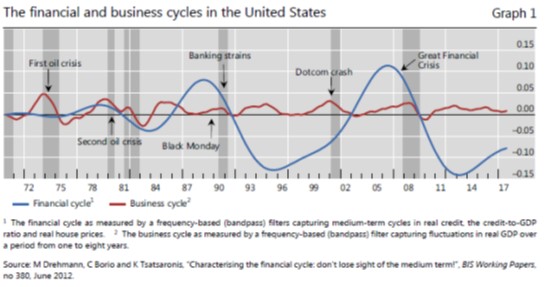|
A very interesting working paper by the BIS, here are some excerpts:
"It is important to highlight key differences between financial cycles and business cycles. Graph 1 illustrates the empirical nature of the differences between the two cycles. Statistical features of the financial cycle obviously differ in various respects. First, financial cycles comprise expansions and contractions of financial conditions rather than of the real side of the economy. In this graph, the proxy for the financial cycle is an aggregate of credit and housing prices. Second, the duration of financial cycles varies and is generally longer than the duration of business cycles. Third, the amplitude of the financial cycle varies more than the business cycle. Fourth, the synchronicity of financial and business cycles appears fairly low. The business cycle does not appear to drive the financial cycle. However, there is a relationship between financial bust phases and serious macro-financial disruptions."
(…)
"However, as pointed out by DeLong and Summers (1986) and Zarnowitz (1992), the historical relationship between financial panics and business cycle contractions is not as close as sometimes thought.
Our study focuses on the longer swings associated with financial cycles, a phenomenon plainly visible in Graph 1. Various features of the financial cycles are notable. The financial cycle does not coincide with the business cycle."
(…)
"Financial cycles are generally of a longer duration (or, in other words, they are a lower frequency phenomenon) than business cycles, and the duration (and amplitude) changes over time.
In addition, when looking at measures of the financial cycle over an even longer time span, the financial cycles do not appear to be solely regime-dependent, at least in some respects."
(…)
"But through it all, recurrent long swings in financial forces are evident."

"One challenge in exploring the financial cycle’s recurrent nature is the ostensible differences of each cycle over time, as is evident in Graph 1."
(…)
"Conventional time-series plots of financial cycles, on the face of it, suggest that the financial cycles are not at all alike. However, as Burns and Mitchell (1946) emphasised when researching business cycles regularities, conventional time-series plots (in calendar time) may obscure some of important regularities that all cycles share. Put differently, calendar time might not be the best way to compare cycles over time."
|